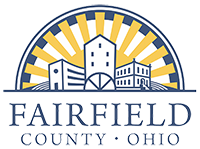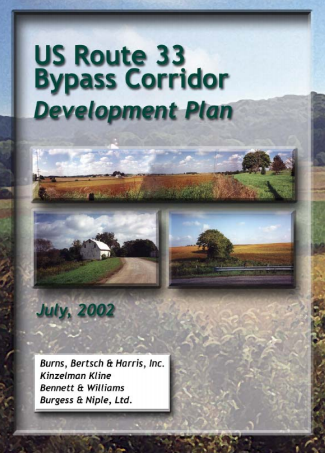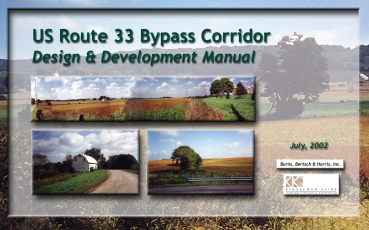REGIONAL PLANNING COMMISSION
U.S. ROUTE 33 BYPASS CORRIDOR
Important growth pressures are being exerted upon the County that will substantially affect the type, quantity, and quality of development in the coming decade. Economic trends, population shifts, and changing preferences related to how and where we live, work, and shop will continue to impact the shape of the communities within central Ohio.
The Fairfield County Commissioners and the Fairfield County Regional Planning Commission recognized the importance and impact of the US Route 33 bypass early; and, in 2001 commissioned a special study to identify issues and formulate recommendations that would promote sound development practices and mitigate negative impacts associated with the construction of the bypass.
The result of the study is two documents - the US Route 33 Bypass Corridor Development Plan and the US Route 33 Bypass Corridor Design Manual. One of the primary aims of the US Route 33 Bypass Corridor Development Plan is to provide local governments and private property owners with a vision for the corridor, one that reflects the public interest. The US Route 33 Bypass Corridor Development Plan does not dictate how any specific parcel should be zoned. Rather, it provides the basis for future zoning decisions by the appropriate governing body. By following the recommendations of both the US Route 33 Bypass Corridor Development Plan and the US Route 33 Corridor Design Manual, it is possible to create economic development opportunities while also preserving the rural landscape and character of the corridor.
The US Route 33 Bypass Corridor Development Plan emphasizes intergovernmental collaboration. The bypass corridor will have a direct affect on three townships and two municipalities. In order to ensure that the region is protected and to ensure that local governments are not pitted against each other in the quest for economic development and the resulting tax revenue, formal communication and coordination is critical. Each political jurisdiction should review both the US Route 33 Bypass Corridor Development Plan and the US Route 33 Corridor Design Manual and then examine their own plans, policies and regulatory tools, identifying areas for adjustment and taking any necessary action. The Fairfield County Regional Planning Commission is prepared to provide support including technical assistance to the cooperating jurisdictions in order to assure that the US Route 33 Bypass Corridor Development Plan's goals are achieved.
U.S. Route 33 Bypass Corridor
Design and Development Manual
Purpose and Use
The U.S. Route 33 Bypass Corridor Plan has been developed to establish a growth ethic for the area impacted by the new Lancaster Bypass. This has been achieved through a public process that established goals, objectives, and policies for the corridor. In addition, the plan addresses future land use, traffic and access management, and utility boundaries.
The intent of this document, The U.S. Rte. 33 Bypass Corridor Design and Development Manual, is that it be used as a companion document to The Corridor Plan. It supplements The Corridor Plan by providing design and development standards that can be used by individuals and organizations seeking to develop within the boundaries of the corridor. (See Figure 2: Corridor Boundary Plan.) The design standards have also been developed as a tool to help those with powers of review evaluate proposals made for development within the boundaries of the Corridor.
The Route 33 Bypass Corridor falls within the jurisdiction of multiple organizations including a village, a municipality and townships. Therefore, a design overlay zone is recommended for the Corridor. The design and development standards found within this document should be the basis for the creation of overlay zoning text. Owners of property in an overlay zone, must not only meet the provisions of the underlying zone, but also the provisions of the overlay zone. Where the provisions of the design overlay zone conflict with the provisions of the underlying zone, the provisions of the design overlay zone will prevail.
It is not the intent of this design manual to impact single family residences and farmsteads that currently exist within the corridor. These properties contribute to the existing character of the area. Future single lot, single family residential dwellings that are not part of a larger residential subdivision are also not subject to the design guidelines within this document.
The Fairfield County Commissioners and the Fairfield County Regional Planning Commission recognized the importance and impact of the US Route 33 bypass early; and, in 2001 commissioned a special study to identify issues and formulate recommendations that would promote sound development practices and mitigate negative impacts associated with the construction of the bypass.
The result of the study is two documents - the US Route 33 Bypass Corridor Development Plan and the US Route 33 Bypass Corridor Design Manual. One of the primary aims of the US Route 33 Bypass Corridor Development Plan is to provide local governments and private property owners with a vision for the corridor, one that reflects the public interest. The US Route 33 Bypass Corridor Development Plan does not dictate how any specific parcel should be zoned. Rather, it provides the basis for future zoning decisions by the appropriate governing body. By following the recommendations of both the US Route 33 Bypass Corridor Development Plan and the US Route 33 Corridor Design Manual, it is possible to create economic development opportunities while also preserving the rural landscape and character of the corridor.
The US Route 33 Bypass Corridor Development Plan emphasizes intergovernmental collaboration. The bypass corridor will have a direct affect on three townships and two municipalities. In order to ensure that the region is protected and to ensure that local governments are not pitted against each other in the quest for economic development and the resulting tax revenue, formal communication and coordination is critical. Each political jurisdiction should review both the US Route 33 Bypass Corridor Development Plan and the US Route 33 Corridor Design Manual and then examine their own plans, policies and regulatory tools, identifying areas for adjustment and taking any necessary action. The Fairfield County Regional Planning Commission is prepared to provide support including technical assistance to the cooperating jurisdictions in order to assure that the US Route 33 Bypass Corridor Development Plan's goals are achieved.
U.S. Route 33 Bypass Corridor
Design and Development Manual
Purpose and Use
The U.S. Route 33 Bypass Corridor Plan has been developed to establish a growth ethic for the area impacted by the new Lancaster Bypass. This has been achieved through a public process that established goals, objectives, and policies for the corridor. In addition, the plan addresses future land use, traffic and access management, and utility boundaries.
The intent of this document, The U.S. Rte. 33 Bypass Corridor Design and Development Manual, is that it be used as a companion document to The Corridor Plan. It supplements The Corridor Plan by providing design and development standards that can be used by individuals and organizations seeking to develop within the boundaries of the corridor. (See Figure 2: Corridor Boundary Plan.) The design standards have also been developed as a tool to help those with powers of review evaluate proposals made for development within the boundaries of the Corridor.
The Route 33 Bypass Corridor falls within the jurisdiction of multiple organizations including a village, a municipality and townships. Therefore, a design overlay zone is recommended for the Corridor. The design and development standards found within this document should be the basis for the creation of overlay zoning text. Owners of property in an overlay zone, must not only meet the provisions of the underlying zone, but also the provisions of the overlay zone. Where the provisions of the design overlay zone conflict with the provisions of the underlying zone, the provisions of the design overlay zone will prevail.
It is not the intent of this design manual to impact single family residences and farmsteads that currently exist within the corridor. These properties contribute to the existing character of the area. Future single lot, single family residential dwellings that are not part of a larger residential subdivision are also not subject to the design guidelines within this document.
RESOURCES


